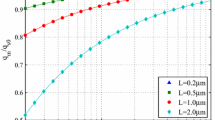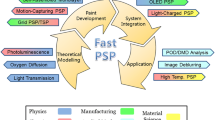Abstract
Global heat-flux measurements are performed using a newly developed temperature-sensitive paint (TSP) on an inclined ramp with sidewalls in a hypersonic shock tunnel. The paint response and image acquisition rate are sufficiently fast to allow flow phenomena on timescales of around \(100\,\upmu \mathrm{{s}}\) to be resolved. Although a priori calibration of the new TSP proves inaccurate, in situ calibration allows the recovery of heat fluxes that agree well with embedded thermocouple measurements on both short and long timescales. At low unit Reynolds numbers, the flow on the main ramp surface is entirely laminar, but transition occurs in the corner-flow regions, causing a turbulent region to spread inwards from each sidewall and producing weak, unsteady features in the heat-flux distribution of the main laminar region. Within this laminar region, roughly steady streamwise streaks with a period of approximately ten times the boundary-layer thickness are also observed. At higher unit Reynolds numbers, the boundary layer on the main ramp surface transitions to turbulence. The fast-response TSP allows tracking of the time-resolved transition front: significant unsteadiness is observed, which appears to be only weakly correlated to unsteadiness in the freestream flow conditions. Based on the heat-flux signature in the transition region, the breakdown mechanism seems to be quite different from that observed in earlier measurements on a slender cone at similar conditions.
Graphical abstract
















Similar content being viewed by others
References
Ames Research Staff (1953) Equations, tables, and charts for compressible flow. NACA Report 1135
Berridge D, Chou A, Ward C, Steen L, Gilbert P, Juliano T, Schneider S, Gronvall J (2010) Hypersonic boundary-layer transition experiments in a Mach-6 quiet tunnel. AIAA Paper No. 2010-1061
Berry SA, Auslender AH, Dilley AD, Calleja JF (2001) Hypersonic boundary-layer trip development for Hyper-X. J Spacecraft Rockets 38(6):853–864
Bertin J, Cummings R (2006) Critical hypersonic aerothermodynamic phenomena. Annu Rev Fluid Mech 38:129–157
Cai Z, Liu T, Wang B, Rubal J, Sullivan JP (2011) Numerical inverse heat transfer analysis for temperature-sensitive-paint measurements in hypersonic tunnels. J Thermophys Heat Tr 25(1):59–67
Cook W, Felderman E (1966) Reduction of data from thin-film heat-transfer gages: a concise numerical technique. AIAA J 4(3):561–562
Eckert ERG (1955) Engineering relations for friction and heat transfer to surface in high velocity flow. J Aeronaut Sci 22(8):585–587
Fischer M (1972) Spreading of a turbulent disturbance. AIAA J 10(7):957–959
Gerhold T, Friedrich O, Evans J, Galle M (1997) Calculation of complex three-dimensional configurations employing the DLR TAU-code. AIAA Paper No. 97-0167
Goonko YP, Latypov AF, Mazhul II, Kharitonov AM, Yaroslavtsev MI (2003) Structure of flow over a hypersonic inlet. AIAA J 41(3):436–447
Hannemann K (2003) High enthalpy flows in the HEG shock tunnel: experiment and numerical rebuilding. In: 41st AIAA Aerospace Sciences Meeting and Exhibit, Reno, Nevada
Hannemann K, Martinez Schramm J (2007) High enthalpy, high pressure short duration testing of hypersonic flows. In: Tropea C, Foss J, Yarin A (eds) Springer handbook of experimental fluid mechanics. Springer, Berlin, pp 1081–1125
Hannemann K, Martinez Schramm J, Karl S, Steelant J (2008) Experimental investigation of different scramjet hydrogen injection systems. In: Proc. 6th European Symposium on Aerothermodynamics for Space Vehicles, Versailles, France
Hannemann K, Karl S, Martinez Schramm J, Steelant J (2010) Methodology of a combined ground based testing and numerical modelling analysis of supersonic combustion flow paths. Shock Waves 20:353–366
Hohn OM, Gülhan A (2017) Experimental investigation of sidewall compression and internal contraction in a scramjet inlet. J Prop Power 33(2):501–513
Hubner JP, Carroll BF, Schanze KS (2002) Heat-transfer measurements in hypersonic flow using luminescent coating techniques. J Thermophys Heat Tr 16(4):516–522
Karl S (2011) Numerical investigation of a generic scramjet configuration. PhD thesis, Technische Universität Dresden, Dresden, Germany
Krek RM, Jacobs P (1993) STN, shock tube and nozzle calculations for equilibrium air. Department of Mechanical Engineering Report 2/93, The University of Queensland
Laurence S, Lieber D, Schramm JM, Hannemann K, Larsson J (2015) Incipient thermal choking and stable shock-train formation in the heat-release region of a scramjet combustor. Part I: Shock-tunnel experiments. Comb Flame 162(4):921–931
Laurence SJ, Karl S, Hannemann K (2013a) Experimental and numerical investigation of the HyShot II flight experiment. In: Proceedings of the 29th International Symposium on Shock Waves (ISSW 29), Madison, WI, USA
Laurence SJ, Karl S, Schramm JM, Hannemann K (2013b) Transient fluid-combustion phenomena in a model scramjet. J Fluid Mech 722:85–120
Laurence SJ, Wagner A, Hannemann K (2016) Experimental study of second-mode instability growth and breakdown in a hypersonic boundary layer using high-speed schlieren visualization. J Fluid Mech 797:471–503
Liu T, Sullivan J (2007) Pressure and temperature sensitive paints. Springer, Berlin
Liu T, Cai Z, Lai J, Rubal J, Sullivan JP (2010) Analytical method for determining heat flux from temperature-sensitive-paint measurements in hypersonic tunnels. J Thermophys Heat Tr 24(1):85–94
Nagayama T, Nagai H, Tanno H, Komuro T (2016) Visualization of hypersonic boundary layer transition on elliptic cone in high enthalpy shock tunnel with temperature-sensitive paint. AIAA Paper No. 2016-0358
Nagayama T, Nagai H, Tanno H, Komuro T (2017) Global heat flux measurement using temperature-sensitive paint in high-enthalpy shock tunnel HIEST. AIAA Paper No. 2017-1682
Ozawa H, Laurence SJ, Schramm JM, Wagner A, Hannemann K (2015) Fast-response temperature-sensitive-paint measurements on a hypersonic transition cone. Exp Fluids 56(1):1853
Roediger T, Knauss H, Estorf M, Schneider S, Smorodsky BV (2009) Hypersonic instability waves measured using fast-response heat-flux gauges. J Spacecraft Rockets 46(2):266–273
Schultz D, Jones T (1973) Heat-transfer measurements in short-duration hypersonic facilities. AGARDograph No 165
Sivasubramanian J, Fasel HF (2015) Direct numerical simulation of transition in a sharp cone boundary layer at Mach 6: fundamental breakdown. J Fluid Mech 768:175–218
Stetson K, Kimmel R (1992) On hypersonic boundary-layer stability. AIAA Paper No. 97-0737
Weinberg BC, Rubin SG (1972) Compressible corner flow. J Fluid Mech 56(4):753–774
White F (1991) Viscous fluid flow, 2nd edn. McGraw-Hill, New York
Acknowledgements
The authors gratefully acknowledge the HEG technical staff, particularly Ingo Schwendtke and Bartek Klaskala, for support and assistance during this experimental campaign. S.J.L. would also like to acknowledge fruitful discussions with T. Zaki, H. Hornung and G. Candler.
Author information
Authors and Affiliations
Corresponding author
Additional information
Publisher's Note
Springer Nature remains neutral with regard to jurisdictional claims in published maps and institutional affiliations.
Electronic supplementary material
Below is the link to the electronic supplementary material.
Rights and permissions
About this article
Cite this article
Laurence, S.J., Ozawa, H., Martinez Schramm, J. et al. Heat-flux measurements on a hypersonic inlet ramp using fast-response temperature-sensitive paint. Exp Fluids 60, 70 (2019). https://doi.org/10.1007/s00348-019-2711-8
Received:
Revised:
Accepted:
Published:
DOI: https://doi.org/10.1007/s00348-019-2711-8




